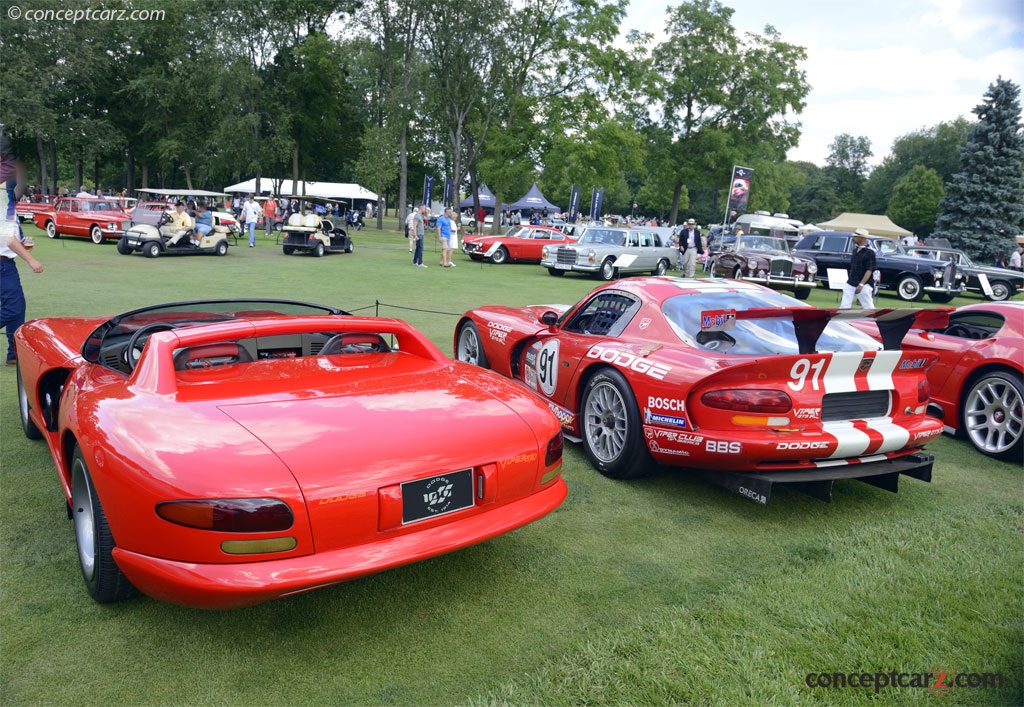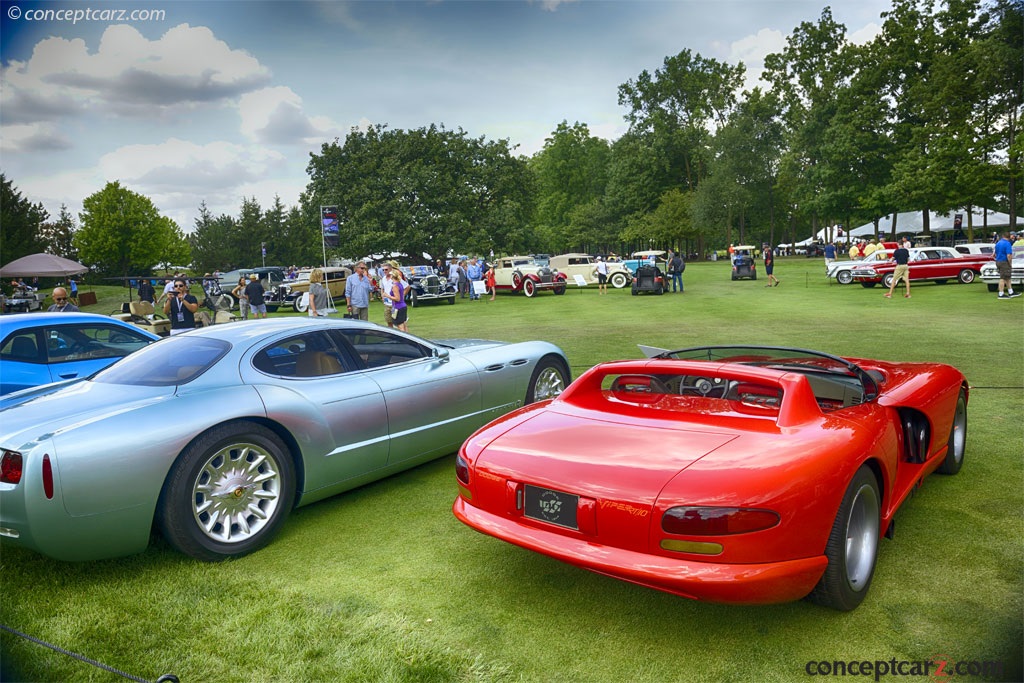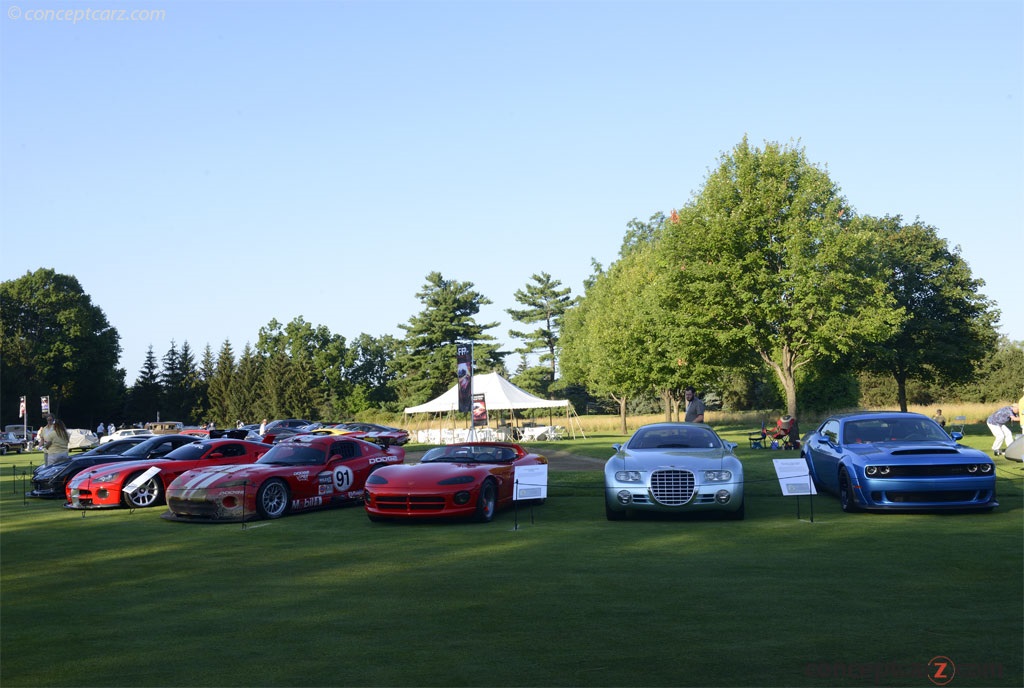Just a few months passed since Chrysler president Bob Lutz suggested to Tom Gale at Chrysler Design Center that the company should consider building a halo model, to the resulting clay model. The design struck a positive chord, and Metalcraters was tasked with producing the sheet metal for the resulting design. Only having been conceived in late 1988 at Chrysler's Advanced Design Studios, the concept was shown in 1989 at the North American International Auto Show. The overwhelmingly positive reception prompted its immediate production. Reality sunk in when Chrysler chairman Lee Iacocca was prompted with approving the $70 million needed for production. Following market and feasibility studies, Iacocca officially approved production in May of 1990. It had been proven that the market existed and the $70 million investment could potentially improve the company's image.
Roadster
View info and historyWhile production approval was pending, conceptual work began in March of 1989, and the production body completed by the Fall of 1989. At the time, Lamborghini was a subsidiary of Chrysler and their expertise made them the most suitable to create a cast-aluminum prototype block for the new sports car. The test mule, however, was equipped with a V8 engine. Carroll Shelby piloted a pre-production Viper as the pace vehicle in the Indianapolis 500 race, well ahead of the production versions being released for media review in November of 1991, followed by first retail shipments beginning in January of 1992. In total, a prototype and two pre-production models were built including the Indy pace car. The Japanese-built Dodge Stealth had been intended to pace the Indy 500 that year, but complaints from the United Auto Workers prompted management to field the Viper. The Lamborghini-designed V10 engine project was based on the Chrysler'S LA V8 engine, weighed 712 lbs, and was rated at 400 horsepower at 4,600 RPM and developed 630 Nm of torque at 3,600 RPM. It had a United States Environmental Protection Agency-rated 12 mpg in the city and 20 mpg on the highway. The engine was installed in the tubular steel frame and clothed with resin transfer molding (RTM) fiberglass panels. With priority given to performance, the early Viper models were devoid of air conditioning, airbags, or exterior-mounted door handles. They did have an AM/FM stereo cassette player with a clock and high fidelity sound system, interior carpeting, and manually-adjustable leather-trimmed sport bucket seats with lumbar support. The roof was constructed from canvas, and the windows were made from vinyl with zippers to open and close. Larger aluminum alloy wheels concealed the necessary large disc brakes. 
Roadster
View info and historyAir conditioning became optional for the 1994 through 1995 models and a lightweight fiberglass hard roof option was offered on later models to cover the canvas sot roof. Most Vipers were offered with an adjustable performance suspension. Unique design features of the early Vipers included the exposed side exhaust pipes, zippered windows, and the lack of door handles. The early SR I models (produced from 1991 through 1995) was able to accelerate from zero-to-sixty mph in 4.2 seconds and had a maximum speed of approximately 165 mph. The second generation of Vipers was introduced in 1996, codenamed the 'SR II,' and remained in production through 2002. They used a single muffler at the rear exiting via two large central tailpipes, which reduced back pressure, and resulted in an increase in power to 415 hp. The removable hardtop had sliding glass windows, greatly improving the car's usability and comfort. The overall weight was reduced by approximately sixty pounds as some of the previous steel components were now built using aluminum. 
Roadster
View info and historyA coupe version of the Viper RT/10 roadster was introduced during the 1996 model year and known as the Viper GTS. Its slightly raised roof sections, similar to design cues of the Shelby Daytona designed by Pete Brock or some Zagato-bodied coachwork, earned it the nickname the 'double bubble.' Both the roadster and the coupe had a similar appearance, however, the GTS was more than ninety-percent new. Power was from the same 7,990cc V10 engine but was rated at 450 horsepower and 490 lb-ft of torque. The GTS was the first Viper to include power windows, power door locks, and air conditioning as standard equipment. For its second time since its brief introduction, the Dodge Viper (this time a GTS) was selected to pace the 1996 Indianapolis 500. Production of the second generation (SR II) continued through 2002 with updates along the way. The third generation (ZB I) of 2003 through 2007 introduced the new Viper SRT-10 wearing a redesign courtesy of DaimlerChrysler's Street and Racing Technology group, with design inspiration sourced from the Dodge Viper GTS-R concept of 2000. The enlarged 8.3-liter engine produced 500 horsepower and 525 lb-ft of torque. Although having a larger displacement size than previous years, its weight was reduced to about 500 pounds. Further weight reduction in the chassis reduced weight by about 80 lbs than the previous model. 
Roadster
View info and historyA fourth generation of the Viper (ZB II) was introduced and remained in production briefly - through 2010 - before entering a short hibernation that ended in 2013 with the introduction of the fifth-generation (VX). The ZB II versions were equipped with a 511.5 cubic-inch V10 engine that produced around 600 horsepower and 560 lb-ft of torque. It used dual electronic throttle bodies, heads with larger valves, and Mechadyne cam-in-cam variable valve timing on the exhaust cam lobes. The previous Tremec T56 transmission was replaced by a new Tremec TR6060 with triple first-gear synchronizers and doubles for higher gears. The Dana M44-4 rear axle used on the 2003 through 2006 models was replaced by a GKN ViscoLok speed-sensing limited-slip differential. Additionally, the run-flat tires were removed and new Michelin Pilot Sport 2 tires were placed at all four corners. Major exterior distinguishable features between the third and fourth generation of the Viper is the vented engine cover.The 2013 SRT Viper was introduced at the New York Auto Show in April of 2012. Its all-aluminum 8.4-liter V10 engine offered 640 horsepower and 600 lb-ft of torque.
by Daniel Vaughan | Feb 2021

Roadster
View info and history

Roadster
View info and history

Roadster
View info and history

Roadster
View info and history
by Daniel Vaughan | Feb 2021
Similarly Sized Vehicles
from 1989
Dodge Monthly Sales Volume
March 2023
50,975
1989 Dodge Viper Concept Vehicle Profiles
Recent Vehicle Additions
Performance and Specification Comparison
Price Comparison
Related Automotive News

HONDA CIVIC TYPE R MAKES NORTH AMERICAN DEBUT AT THE 2016 SEMA SHOW
Oct 28, 2016 - TORRANCE, Calif.
Civic Type R headlines Civicpalooza display featuring more than nine tuned, accessorized and custom-built Civic Sedans, Coupes and Hatchbacks
10th Generation Civic Racing vehicles include 2016...

CAMARO AT THE BRICKYARD
Nine pace cars trace the history of Camaro and the Indianapolis 500
INDIANAPOLIS – Among the milestones surrounding the 100th running of the Indianapolis 500 this weekend is Chevrolets legacy as the official pace car – an honor it has held more...

Buick's Performance Legacy: 10 that Mattered
Milestone vehicles that established and advanced the brands performance heritage
DETROIT – Performance has been part of Buicks DNA since its earliest days, when stripped-down chassis and powerful Buick engines pushed the pioneers of...

World-premiere: All-new 2015 Alfa Romeo 4C Spider Delivers Race-inspired Performance, Advanced Technologies, Seductive Italian Style, and now an Even More Exhilarating Driving Experience With Open-air Freedom
Production version of the all-new 2015 Alfa Romeo 4C Spider, revealed at the 2015 North American International Auto Show, will arrive at dealerships this summer All-new 2015 Alfa Romeo 4C Spiders open-air performance cockpit and mid-engine propo...
HONDA INDY GRAND PRIX OF ALABAMA TALKING POINTS
-This weekends Honda Grand Prix of Alabama will be the fourth IZOD IndyCar Series event at the scenic, 2-3-mile Barber Motorsports Park circuit, and marks the third year American Honda has served as title sponsor of the event.
-American Honda also sponsored...




























